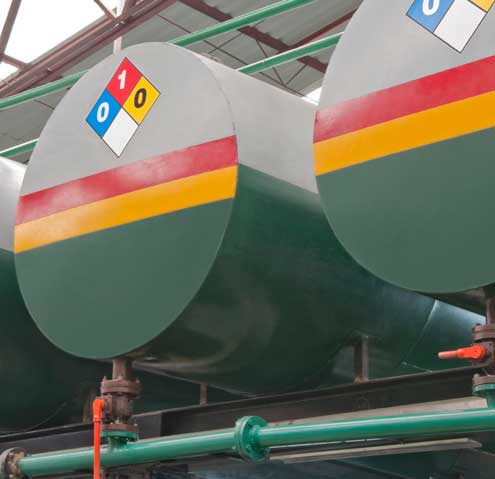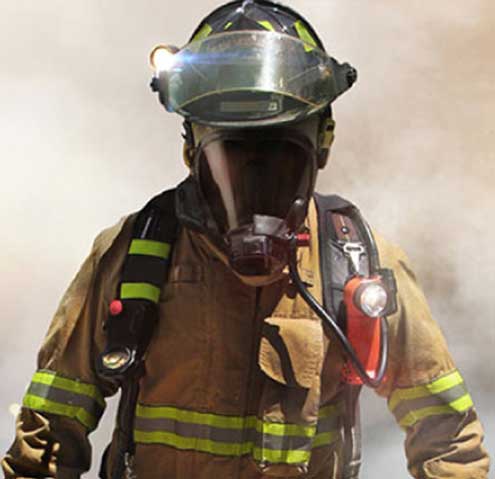VelocityEHS Training & Learning users get unlimited access to our growing library of expert designed eLearning courses covering a wide variety of EHS and workplace training topics. On-demand, mobile access means users can access high-quality interactive training content anywhere and any time, while built-in knowledge checks and evaluation tools help boost retention and make it easy to track training performance every step of the way.
eLearning Course Library
Course Topics
Click on the topics below to browse our entire course library and view course descriptions.
HAZMAT
Equip your employees with the latest in GHS, HazCom, HAZWOPER, SDS, Spill Prevention & Control and DOT Material Transport & Handling Information. Learn More
HR Employment
Give your employees the knowledge and skills to build a happier, healthier and safer workplace Learn More
Emergency Response Planning
Make sure your employees are prepared to respond when lives are on the line. Learn More
Personal Protective Equipment (PPE)
PPE is the last, and sometimes only line of defense between workers and potentially deadly workplace hazards. Make sure you've got the highest level of protection. Learn More
Workplace Safety
A broad range of courses to help you and your employees work safer, no matter what your industry Learn More
Lab Safety
A diverse set of courses designed to cover the unique hazards and equipment encountered in laboratories Learn More
Environmental Compliance
Build a more sustainable organization through enhanced awareness of environmental risks and regulations. Learn More
Work From Home
With an increasing number of employees working remotely these days, it's more important than ever to manage the often unforeseen risks to worker health and safety. Learn More
HAZMAT
DOT Security Awareness
DOT Security Awareness covers the DOT Security Requirements rule as it applies to companies who work with and transport hazardous materials. It is designed to meet the security awareness training requirement with coverage including: security risks related to the transportation of hazmat, evaluating potential threats to security, Department of Homeland Security's warning system, and secure practices for transporting hazardous substances. Primary Regs: The DOT Security Requirements rule
DOT Shippers Training
DOT Shippers Training provides training for shippers of hazardous materials on the regulations and requirements that must followed under the HMR including a general understanding of what constitutes a "hazardous material", how to use the hazardous materials table, required HAZMAT shipping paperwork, labeling, and placarding. Primary Regs: Hazardous Materials Regulations (HMR), 49 CFR Parts 171-180
DOT Transporters
DOT Transporters provides training for drivers and personnel who transport hazardous materials regarding the requirements they must follow under Federal law. Coverage includes the basic requirements of the Hazardous Materials Regulations, training requirements, distinguishing between non-hazardous and regulated hazardous materials, identifying hazard classes and divisions, required shipping paperwork, placarding and labeling rules, proper loading, material compatibility, emergency response procedures, and other related topics. Primary Regs: Hazardous Materials Regulations (HMR), 49 CFR Parts 171-180
Hazard Communication: GHS Training
Hazard Communication covers training required by OSHA's Hazard Communication Standard (HCS), recently updated to reflect guidelines from the United Nation’s Globally Harmonized System of Classification and Labeling (GHS). The HCS requires that hazardous materials used at the work site are identified, labeled, handled, used, and disposed of properly. This course is designed to help prevent or minimize employee exposures to harmful materials and minimize accidental releases of the hazardous materials into the work environment. Additionally, special attention is paid to new Safety Data Sheet and Labeling requirements. Primary Regs: OSHA 29 CFR 1910.1200, Hazard Communication.
Hazard Communication: GHS Training (Spanish)
Hazard Communication covers training required by OSHA's Hazard Communication Standard (HCS), recently updated to reflect guidelines from the United Nation’s Globally Harmonized System of Classification and Labeling (GHS). The HCS requires that hazardous materials used at the work site are identified, labeled, handled, used, and disposed of properly. This course is designed to help prevent or minimize employee exposures to harmful materials and minimize accidental releases of the hazardous materials into the work environment. Additionally, special attention is paid to new Safety Data Sheet and Labeling requirements. Primary Regs: OSHA 29 CFR 1910.1200, Hazard Communication.
Hazard Communication Awareness-Refresher: GHS Training
Employers are required to train all employees on the New Label Elements and SDS Format adopted from the United Nation’s Globally Harmonized System of Classification and Labeling (GHS). This course is for employees that have been previously trained on Hazard Communication, but require refresher training. Special attention is paid to Safety Data Sheet and Labeling requirements, as well as an examination of the Hazard Classifications. Primary Regs: OSHA 29 CFR 1910.1200, Hazard Communication.
Hazard Communication Awareness-Refresher: GHS Training (Spanish)
Employers are required to train all employees on the New Label Elements and SDS Format adopted from the United Nation’s Globally Harmonized System of Classification and Labeling (GHS). This course is for employees that have been previously trained on Hazard Communication, but require refresher training. Special attention is paid to Safety Data Sheet and Labeling requirements, as well as an examination of the Hazard Classifications. Primary Regs: OSHA 29 CFR 1910.1200, Hazard Communication.
HAZWOPER 8-hour Refresher
HAZWOPER 8-hour Refresher meets the annual refresher-training requirement for regular hazardous waste site workers and managers. The eight-hour course provides refresher coverage of material in the original 24 or 40 hour training course for hazardous waste operations and emergency response and includes the following ten modules: Site Safety and Health Plans and Procedures; Decontamination; Hazard Communication; Working in Extreme Temperatures; Fire and Explosion Safety; Emergency Response and Spill Control; PPE/Respiratory Protection; Site Control; Regulatory Overview and Toxicology. Students in this course must complete and pass all modules with a final “time-in-course” of 8 hours or more in order to meet the regulatory requirement for annual Hazwoper Refresher training. Primary Regs: OSHA 29 CFR 1910.120, Hazardous Waste Operations and Emergency Response. (Special Pricing Applies)
Material Handling & Storage Procedures
Material Handling & Storage Procedures covers precautions and safe work practices for handling and storage of drums, compressed gas cylinders, flammable materials, slings, safe lifting techniques, and general safe handling procedures. Primary Regs: OSHA 29 CFR 1910 Subpart N, Materials Handling and Storage.
Safety Data Sheets: GHS Training
Safety Data Sheets expands on training required by OSHA's revised Hazard Communication Standard (HCS), and takes a deep dive into how to interpret the 16-section GHS Safety Data Sheet (SDS) format. Included in this course are comprehensive explanations of each section, along with detailed definitions of specific chemical properties, physical and health hazards, and discussion on how information contained in each section may impact employees' day-to-day work. Primary Regs: OSHA 29 CFR 1910.1200, Hazard Communication
Spill Prevention & Control
Spill Prevention & Control covers hazardous materials, spill control, and confinement methods including information about the safe handling, movement, and storage of hazardous materials. Primary Regs: OSHA 29 CFR 1910 Subpart H, Hazardous Materials
Workplace Safety
Arc Flash Safety Awareness, NFPA 70E
Arc Flash Safety Awareness, NFPA 70E is required for anyone who might potentially be exposed to hazards related to working on or near energized electric components, including those who could inadvertently approach such hazards. The course provides awareness training on arc flash hazards, NFPA 70E requirements, and safe work practices for both qualified and unqualified workers. The training will help you: understand what arc flashes and blasts are and the injuries that can result, know the difference between unqualified and qualified personnel, identify the three types of boundaries, limited, restricted, and prohibited, know the personal protective equipment requirements for protection in the different boundaries, be aware of warning labels and signs used to mark hazards, and create safe working conditions related to arc flash safety. Primary Regs: NFPA 70E Article 130 (and others), OSHA 1910 Subpart S, NEC 2008 (National Electric Code) Article 110.16
Back Safety
Back Safety (for all employees) provides general back safety awareness relating to job hazards, safe work practices, and ergonomics issues. Coverage includes: information on the extent of back injury problems in the workplace, recognition and control of occupational ergonomic hazards, good practices for reducing back injuries, conducting ergonomics assessments, and engineering controls. Primary Regs: OSHA 29 CFR 1903.1, The General Duty Clause.
Basic Construction Safety
Basic Construction Safety provides an overview of the hazards inherent in construction work, and identifies principles and practices to mitigate them. Coverage includes general considerations for contractors and employees related to requirements for tools and equipment, hazards within confined spaces, working safely around cranes, electricity, Lockout/Tagout procedures, trenching and excavation work, fall protection, hand and power tools, Hazcom, PPE, material handling, ladder and scaffolding safety, inspection and storage of materials. Primary Regs: OSHA 29 CFR 1926 Subpart C - General Safety and Health Provisions
Behavior-based Safety Training
Behavior-based Safety Training provides supervisors with an overview of the concepts of behavior-based safety including how to apply behavior-based safety techniques in their day-to-day duties and responsibilities. Primary Regs: OSHA 29 CFR 1903.1, The General Duty Clause
Bloodborne Pathogens
Bloodborne Pathogens provides training and procedures that will help minimize health risks for workers at risk for exposure to blood and other potentially infectious materials. Coverage includes recognizing hazards, identifying modes of transmission, standard precautions, appropriate engineering controls, work practices, and PPE to prevent exposure, and emergency procedures for incidents involving exposure. Primary Regs: OSHA 29 CFR 1910.1030, Bloodborne Pathogens
Bloodborne Pathogens - Awareness/Refresher
Carcinogen Safety
Carcinogen Safety provides instruction in the recognition, management, safe use, and control of carcinogens, including information on MSDS and label requirements and risk assessment. Primary Regs: 29 CFR 1990, Identification, Classification, and Regulation of Potential Occupational Carcinogens; National Toxicology Program (NTP) 1998 Report On Carcinogens, Eighth Edition
Compressed Gases
Compressed Gas Safety provides training needed to help both employers and employees control the physical and health hazards associated with compressed gases and the knowledge needed to work safely with compressed gases. Primary Regs: OSHA 29 CFR, 1910.101, Compressed gases (general requirements).
Confined Space Entry
Confined Space Entry provides coverage of confined spaces, hazardous atmospheres, necessary equipment, and required permits including information about the hazards and hazard control methods that will permit safe work in enclosed work areas or confined spaces. Primary Regs: OSHA 29 CFR 1910.146, Permit-Required Confined Spaces
Defensive Driving
Defensive Driving provides defensive driving techniques and accident prevention methods which will help reduce your chances of being in a motor vehicle accident. Primary Regs: OSHA 29 CFR 1903.1, The General Duty Clause
Electrical Safety
Electrical Safety provides training on the general electrically-related safety practices as required by 29 CFR 1910.331 through 29 CFR 1910.335 pertaining to job hat may involve working with electrical equipment or being exposed to live electrical wiring or devices. It is not intended to provide the depth of coverage required for qualified electrical workers. Primary Regs: OSHA 29 CFR 1926 Subpart K, Electrical - Installation Safety Requirements; OSHA 29 CFR 1910 Subpart S, Electrical - Safety-Related Work Practices
Eye & Face Protection
Eye and Face Protection is required training for anyone who may enter or work within environments where conditions or operations present hazards to eyes or faces. This course will help you: be aware of the general requirements of OSHA's eye and face protection standard 29 CFR 1910.133, recognize eye and face hazards, identify what protective equipment is required to protect you from specific hazards, understand proper fit of protective eyewear, be aware of special issues related to corrective lenses, and know how to clean and maintain protective eyewear. Primary Regs: OSHA 29 CFR 1910.133; Personal Protective Equipment
Fall Protection
Fall Protection provides basic fall protection principles to employees who might be exposed to fall hazards. Upon successful completion of this course, students will be able to identify hazards, specify guidelines for fall protection systems, recognize methods to minimize the risk of falls, specify employer and employee roles and responsibilities in fall protection, and recognize safety equipment limitations. Primary Regs: OSHA 29 CFR 1910 Subpart D, Walking-Working Surfaces; OSHA 29 CFR 1910 Subpart F, Powered Platforms, Man-lifts, and Vehicle-Mounted Work Platforms; OSHA 29 CFR 1926 Subpart M, Fall Protection; OSHA 29 CFR 1926 Subpart L, Scaffolds; OSHA 29 CFR 1926 Subpart E, Personal Protective and Life Saving Equipment; OSHA 29 CFR 1926 Subpart X, Stairways and Ladders; OSHA 29 CFR 1926 Subpart P, Excavations
Fire Safety & Prevention
Fire Prevention covers basic fire safety principles, including the recognition and prevention of potential fire hazards and proper emergency procedures such as fire extinguisher operation and maintenance along with information required by OSHA’s Workplace Fire Protection Program, including employer's responsibilities, exit plans, fire fighting equipment, and training to prevent fire, death, and injury. Primary Regs: OSHA 29 CFR 1910.38, Fire Protection; OSHA 29 CFR 1926 Subpart F, Fire Protection and Prevention; OSHA 29 CFR 1910 Subpart E, Means of Egress
Forklift Safety
Forklift Safety provides the academic background; theory and exercises required to understand standard safety practices and habits for the safe operation of forklifts, including: forklift physics, proper operation procedures, rules, forklift safety practices, general maintenance and safe refueling/recharging procedures. Hands-on driver training is required for the specific forklift models in employed. Primary Regs: OSHA 29 CFR 1910.178, Powered Industrial Trucks
Forming Effective Safety Committees
Forming Effective Safety Committees introduces managers to best practices for establishing and maintaining a joint employee-management safety committee as one of the most effective means of increasing employee involvement in the safety program. Primary Regs: OSHA 29 CFR 1903.1, The General Duty Clause, Section 5(a)(2)
Hand & Finger Safety
Hand and Finger Safety provides an overview of hazards and safety measures designed to prevent hand and finger injury including: common injuries, hazards posed by tools, safe practices for working around equipment, effective engineering and administrative controls, the importance of machine guards and PPE. Primary Regs: OSHA 29 CFR 1910.132 (d)(l); OSHA 29 CFR 1926 Subpart I, Tools - Hand and Power; OSHA 29 CFR 1910.212, Machine Guarding Requirements; OSHA 29 CFR 1910 Subpart I, Personal Protective Equipment
Hand & Power Tool Safety
Hand and Power Tool Safety covers the potential hazards and general safety precautions required for hand tools and power tools in the workplace. Power tool hazards are addressed by power source used, including: pneumatic, liquid fueled, hydraulic, and powder-actuated. Primary Regs: OSHA 29 CFR 1926 Subpart I, Tools - Hand and Power; OSHA 29 CFR 1910 Subpart P, Hand and Portable Powered Tools and Other Hand-Held Equipment
Hearing Conservation
Hearing Conservation provides training to help employees prevent noise-induced hearing loss. It also explains the purpose and components of a Hearing Conservation Program. Primary Regs: OSHA 1910.95, Occupational Noise Exposure
Hoisting and Rigging
Hoisting and Rigging provides an overview of safety issues applicable to the operation of cranes and derricks such as: crawler, locomotive, and truck cranes; hammerhead tower cranes; overhead and gantry cranes, floating and barge-mounted cranes, helicopter crane operations, and more. Includes general safety requirements, manufacturer’s roles, required skills for supervisors, equipment inspections, basic operator and rigger skills and safety concepts as well as techniques for handling, attaching, and moving loads. Primary Regs: OSHA 29 CFR 1926.556, Aerial Lifts; OSHA 29 CFR 1926.605, Protection of Employees Working on Barges; OSHA 29 CFR 1926.550, Cranes and Derricks; OSHA 29 CFR 1926.551, Helicopters; OSHA 29 CFR 1926.552, Material Hoists, Personnel Hoists, and Elevators; OSHA 29 CFR 1926.553, Base-Mounted Drum Hoists; OSHA 29 CFR 1926.554, Overhead Hoists; OSHA 29 CFR 1926.555, Conveyors
Indoor Air Quality
Indoor Air Quality provides training to help prevent, identify, and correct indoor air quality problems in buildings and work areas. It recommends practical actions that can be carried out by facility management, maintenance personnel and building occupants. The course will help integrate IAQ-related considerations into your existing organization and work process. Primary Regs: ASHRAE Standard 62-1989, Ventilation. ASHRAE Standard 55-1981, Thermal Environmental Conditions for Human Occupancy.
Indoor Crane & Sling
Indoor Crane and Sling covers basic crane and sling safety training requirements applicable to moving large, heavy loads within manufacturing and construction environments. Coverage includes understanding the manufacturer’s role in crane and sling safety, operator and crew responsibilities, required skills for supervisors, equipment inspections, basic operator and rigger skills and safety concepts as well as techniques for handling, attaching, and moving loads. Primary Regs: OSHA 29 CFR 1926.556, Aerial Lifts; OSHA 29 CFR 1926.605, Protection of Employees Working on Barges; OSHA 29 CFR 1926.550, Cranes and Derricks; OSHA 29 CFR 1926.551, Helicopters; OSHA 29 CFR 1926.552, Material Hoists, Personnel Hoists, and Elevators; OSHA 29 CFR 1926.553, Base-Mounted Drum Hoists; OSHA 29 CFR 1926.554, Overhead Hoists; OSHA 29 CFR 1926.555, Conveyors
Ladder & Scaffolding Safety
This course provides training in how to recognize and safeguard against the hazards associated with using ladders on the job. It focuses mostly on portable ladders including step ladders, straight ladders, extension ladders and platform ladders. The course covers selection of the correct ladder for the job, inspecting, safely setting-up, ascending, descending, maintenance, and proper storage of portable ladders. Primary Regs: OSHA 29 CFR 1926.1060 Subpart X, Stairways and Ladders
Lead Safety Awareness
Lead Safety Awareness provides general knowledge on the hazards associated with lead exposure as well as information regarding the Medical Surveillance Program, the Medical Removal Protection Program, respirator use, specific controls and work practices to reduce lead exposure. Primary Regs: OSHA 29 CFR 1910.1025, Toxic and Hazardous Materials, Lead.
Lockout-Tagout
Lockout-Tagout provides training on safety procedures for the control of hazardous energy and work under the protection of a lockout/tagout permit. Coverage includes: the purpose and requirements of a lockout/tagout program, defining lockout/tagout terms, identifying the limitations of tags, and reviewing the hazards and consequences of operating machines or equipment that have been locked out or tagged out. Primary Regs: OSHA 29 CFR 1910.147, The Control of Hazardous Energy.
Lockout-Tagout Awareness/Refresher
Lockout-Tagout Awareness/Refresher provides overview or refresher training on safety procedures for the control of hazardous energy and work under the protection of a lockout/tagout permit. Primary Regs: OSHA 29 CFR 1910.147, The Control of Hazardous Energy.
Machine Guarding
Machine Guarding covers definitions and requirements for different kinds of machinery with regard to the machine guards and safety procedures including an overview of various guarding methods and terms. Primary Regs: OSHA 29 CFR 1910.212, Machine Guarding Requirements.
OSHA Investigations & Inspections
OSHA Investigations & Inspections covers how to prepare for and respond to an OSHA inspection starting with a strong safety and compliance program. Some of the many topics include: what actions can prompt inspections, what to expect in an inspection, how to respond to questions, how to provide documentation for review, your rights regarding confidential and proprietary information, steps in documenting the inspection, interviews of employees, hazard abatement expectations, responding to a citation, successful participation in informal conferences and settlement agreements, and others. Primary Regs: OSHA 29 CFR 1904 NEW, Recording and Reporting Occupational Injuries and Illness
Preventing Strains & Sprains
Preventing Strains and Sprains provides information that can help workers reduce the risks of muscle and joint injury both on and off the job through increased awareness and better work practices. This course helps workers understand how their muscles, ligaments and bones work together to enable movement and how these tissues are vulnerable to injury. The program identifies the risk factors for injury and reviews basic safety practices along with teaching the techniques for effective warm-up and stretching exercises. Primary Regs: OSHA 29 CFR 1903.1, The General Duty Clause.
Process Safety Management Program
Process Safety Management Program is designed to help employees and contractors who work at industrial process plants to recognize the potential health and safety implications associated with their jobs. This course provides training that can help prevent or minimize the consequences of a catastrophic release of toxic, reactive, flammable, or explosive Highly Hazardous Chemicals (HHC) from a process. Primary Regs: OSHA 29 CFR 1910.119, Process Safety Management of Highly Hazardous Chemicals. OSHA 29 CFR 1910.119, Appendix A, List of Highly Hazardous Chemicals, Toxics, and Reactives OSHA Directives CPL 2-2.45A CH-1. Process Safety Management of Highly Hazardous Chemicals – Compliance Guidelines and Enforcement Procedures (1994, September 13). CPL 2.94. OSHA Response to Significant Events of Potentially Catastrophic Consequences (1991, July 22).
Slips, Trips, and Falls
Slips, Trips, and Falls provides training in how to recognize hazards and prevent accidents including the key components of ladder safety. Primary Regs: OSHA 29 CFR 1910 Subpart D, Walking-Working Surfaces; OSHA 29 CFR 1926 Subpart E, Personal Protective and Life Saving Equipment; OSHA 29 CFR 1910 Subpart F, Powered Platforms, Man-lifts, and Vehicle-Mounted Work Platforms; OSHA 29 CFR 1926 Subpart L, Scaffolds; OSHA 29 CFR 1926 Subpart M, Fall Protection; OSHA 29 CFR 1926 Subpart P, Excavations; OSHA 29 CFR 1926 Subpart X, Stairways and Ladders
Toxicology
Toxicology covers toxicology basics and protection from chemical exposure. It provides information on the types of toxic agents, routes of entry into the body, symptoms of exposure, principles of chemical exposure limits, and factors that influence the effects of chemical exposure. Primary Regs: OSHA 29 CFR 1910.120, Hazardous Waste Operations and Emergency Response
Trenching and Excavation Safety
Trenching and Excavation covers required training related to the hazards and safety principles unique to trenching and excavating including: planning factors, site assessment, different types of excavation methods, confined space requirements, general safety principles, causes of excavation and trenching related fatalities, cave-in accidents, and recognizing hazards present during trenching and excavation work. Primary Regs: OSHA 29 CFR 1926.650 Subpart P, Excavations
Universal Egress Safety
Universal Egress Safety covers information for both employees and supervisors on egress safety measures including: preparation for evacuation situations, recognizing egress hazards, safe housekeeping practices, training, emergency action planning, communicating the plan to all personnel, and enforcing the plan. The course outlines the different roles and responsibilities within the organization related to ensuring proper egress safety compliance for the facility. Primary Regs: OSHA 1910.36, General Requirements; OSHA 1910.37, Means of Egress, General; OSHA 1910.38, Employee Emergency Plans and Fire Prevention Plans
Welding, Cutting and Brazing
Welding, Cutting and Brazing covers the unique combination of safety and health hazards related to welding activities including arc welding and cutting, safety program elements, handling and storage of compressed gas cylinders, oxygen safety practices, use of PPE, fire prevention, ventilation, confined spaces, toxic coatings, and more. Primary Regs: OSHA 29 CFR 1910 Subpart Q, Welding, Cutting & Brazing.
Winter Driving Safety
Winter Driving Safety provides easy to follow driving techniques to increase your safety while operating a motor vehicle in adverse winter weather conditions. Coverage includes proper vehicle maintenance, recognizing and responding to varying weather conditions and hazards, defensive driving tips for winter driving, personal safety considerations, appropriate actions in a breakdown or accident situation.
Working in Extreme Temperatures
Working in Extreme Temperatures provides training in identifying and avoiding hazards related to extreme temperature exposure on the job, including: recognizing symptoms of heat and cold-related illnesses, factors that affect the body’s ability to withstand temperature extremes, steps to reduce the risk of illness or injury, first aid measures for heat and cold-related illnesses, and precautions regarding to use of PPE in extreme temperature environments. Primary Regs: OSHA 29 CFR 1903.1, The General Duty Clause, Section 5(a)(1)
Working Safely: Job Safety Analysis (General)
Working Safely: Job Safety Analysis (General) covers the purpose of safe work practices, assessment tools for identifying workplace hazards, job safety analysis (JSA), its methods, and steps, JSA control methods, effectiveness and limitations of each method, workplace inspection components, workplace housekeeping practices, and more. Primary Regs: OSHA 29 CFR 1910 Subpart D, Walking-Working Surfaces; OSHA 29 CFR 1910 Subpart E, Means of Egress; OSHA 29 CFR 1910 Subpart G, Occupational Health and Environmental Control
Working Safely: JSA Supervisor (Job Safety Analysis Supervisor)
Working Safely: Job Safety Analysis (Supervisor) provides training for supervisors in identifying and controlling hazards on the job. The course is designed to help supervisors establish a safe work practices program and reduce the risk of injury from work place hazards. Coverage includes: hazard assessment tools, JSA methods and steps, JSA controls, the effectiveness and limitations of each method, workplace inspection components, workplace housekeeping practices, and more. Primary Regs: OSHA 29 CFR 1910 Subpart D, Walking-Working Surfaces; OSHA 29 CFR 1910 Subpart E, Means of Egress; OSHA 29 CFR 1910 Subpart G, Occupational Health and Environmental Control
Workplace Safety Orientation
Workplace Safety Orientation is ideal for new hires and workers needing an awareness-level orientation to basic industrial safety fundamentals. It provides an overview of general safety concepts and techniques used to protect workers and includes content covering: Hazard Communication, Bloodborne Pathogens, Lockout-Tagout, Confined Space Entry, PPE, Emergency Response Planning, and Respiratory Protection. Primary Regs: OSHA 29 CFR 1903.1, The General Duty Clause
HR Employment
Drug-Free Workplace Orientation
Drug-Free Workplace provides employees and supervisors with required training related to a drug-free workplace policy including: the impact and prevalence of drugs in the workplace, policy goals, possible signs of abuse, actions to take when abuse is suspected, stages of addiction, circumstances that could prompt drug testing, Employee Assistance Programs, and the supervisor's role. Primary Regs: OSHA 29 CFR 1903.1, The General Duty Clause
HIPAA Privacy for Health Care Providers and Plans
This course provides a basic understanding of the key elements of the HIPAA Privacy, HIPPA Security, Enforcement and Breach Notification rules as they apply to covered entities, business associates and contractors. It instructs employees on the requirements of the rules and how to effectively safeguard the privacy and security of patients’ health information, while helping to foster a privacy-conscious workplace culture. Key learning objectives in the course include: reviewing the background, purpose and scope of the HIPAA rules, identifying the entities covered by the rules, defining what information constitutes protected health information (PHI), understanding both permitted and required disclosures of PHI, learning the requirements for protecting PHI under the privacy and security standards, differentiating between incidental disclosures of PHI and violations of the rules, and being aware of the impact of the Enforcement and Breach Notification rules. Primary Regs: Health Insurance Portability and Accountability Act (HIPAA); 45 CFR Part 160; 45 CFR Part 162; 45 CFR Part 164
Office Safety
Office Safety covers common hazards and safety practices for office environments including ergonomics, stress, hazard communication, bloodborne pathogens, electrical safety, and emergency evacuation. The course identifies employer and employee responsibilities under the Hazard Communication Standard and other applicable regulations, defines common terms and elements of various office safety programs, and specifies controls and work practices to reduce risk factors for office injuries. Primary Regs: OSHA 29 CFR 1903.1, The General Duty Clause, Section 5(a)(2)
Preventing Discrimination in the Workplace
Preventing Discrimination in the Workplace defines what constitutes discrimination in the workplace and outlines the steps employers and emerployees can take to prevent and respond to it. The course helps all employees understand the impact that discrimination has on people and the work environment and that it is everyone’s responsibility to prevent discrimination. Primary Regs: Equal Employment Opportunity Act of 1972
Sexual Harassment (All Employees)
Sexual Harassment (All Employees) is a comprehensive course designed for all employees. It defines sexual harassment, provides examples of what constitutes sexual harassment, and outlines the steps employees and employers can take to prevent and respond to sexual harassment in the workplace. Primary Regs: Title VII, Civil Rights Act of 1964
Sexual Harassment (Awareness level)
Sexual Harassment Awareness/Refresher is a 25-minute overview course designed to provides awareness or refresher training on recognizing and preventing sexual harassment, including examples of sexual harassment and steps employers and employees can take to prevent and respond to sexual harassment in the workplace. Primary Regs: Title VII, Civil Rights Act of 1964
Stress Management
Stress Management provides training in recognizing the signs of stress, defining its effects, learning how to control and relieve stress and developing skills for resolving conflict. The course helps you learn to manage and deal with everyday stressful situations in and out of the workplace.
Workplace Diversity
Workplace Diversity helps workers understand and appreciate diversity in the workforce as it relates to things like attitudes toward authority, motivation and teamwork. Students will learn to appreciate opportunities resulting from a diverse workforce, understand the non-discrimination legislation, identify objectives for a diversity policy, and recognize the negative influences of stereotypes and attitudes. Primary Regs: Equal Employment Opportunity Act of 1972
Workplace Violence
Workplace Violence is designed for all employees and provides instruction on reducing the risks of becoming a victim of the second leading cause of fatal occupational injury in the U.S. It includes information on the environmental conditions to avoid, control strategies, and advice on recognizing warning signs and dealing with volatile situations. Primary Regs: NIOSH [1992]. Homicide in U.S. workplaces: a strategy for prevention and research. Morgantown, WV: U.S. Department of|Health and Human Services, Public Health Service, Centers for Disease Control, National Institute for Occupational Safety and Health, DHHS (NIOSH) Publication No. 92–103; NIOSH [1993]. NIOSH Alert: request for assistance in preventing homicide in the workplace. Cincinnati, OH: U.S. Department of Health and Human Services, Public Health Service, Centers for Disease Control and Prevention, National Institute for Occupational Safety and Health, DHHS (NIOSH) Publication No. 93–109; NIOSH [1995]. National Traumatic Occupational Fatalities (NTOF) Surveillance System. Morgantown, WV: U.S. Department of Health and Human Services, Public Health Service, Centers for Disease Control and Prevention, National Institute for Occupational Safety and Health.
Lab Safety
Laboratory Safety Overview
Laboratory Safety Overview identifies general requirements of the Laboratory Safety Standard and Chemical Hygiene Plans. It provides safety guidelines to protect against common laboratory hazards such as chemical exposure, fires, burns, and general emergency guidelines to be followed in the laboratory. Primary Regs: OSHA 29CFR 1910.1450, Laboratory Standard
Chemical Hygiene
This course provides an overview of chemical hygiene requirements and practices in laboratories. The course was revised to incorporate changes related to OSHA's revised Hazard Communication Standard incorporating GHS standards for hazard classification and communication. Coverage includes background on the Laboratory Safety Standard 29 CFR 1910.1450, the role of a Chemical Hygiene Plan, employee rights and responsibilities, general lab safety guidelines, chemical hazard labels, Safety Data Sheets, and more. Primary Regs: OSHA 29 CFR 1910.1450, Laboratory Standard
Corrosives
Corrosives covers the hazards presented by corrosive chemicals found in the laboratory and the precautions that should be followed in the safe handling and storage of these agents, along with information on PPE usage and first aid procedures for exposure to corrosives. Corrosive burns are among the most common lab injuries. Primary Regs: OSHA 29 CFR 1910.1450, Laboratory Standard
Ergonomics
Ergonomics covers preventative measures to reduce risk of injury to joints, muscles, nerves, bones and tendons resulting from laboratory procedures requiring long, intensive tasks involving awkward and repetitive movements. Examples include: repetitive pipetting, keyboard and mouse use, microscopy, and micromanipulation. The course helps students: identify risk factors for cumulative trauma disorders, recognize specific ergonomic hazards, identify injury symptoms and understand control factors. Particular attention is given to common laboratory risk factors such as: forceful exertions, repetition, deviated posture, contact stresses and sustained static exertions. Primary Regs: OSHA 29 CFR 1910.1450, Laboratory Standard
Flammables
Flammables covers fire hazards in the laboratory and proper safety precautions including handling and storage of flammable chemicals, chemical properties related to flammability (such as flash point, vapor pressure, vapor density, etc.), chemical compatibility, environmental considerations, Uniform Fire Code requirements, spill control techniques, fire extinguisher types, and the proper use of fire extinguishers. Primary Regs: OSHA 29 CFR 1910.1450, Laboratory Standard
Fume Hoods
Fume Hoods covers the proper use of fume hoods to reduce the risk of injury from inhalation of hazardous chemicals. Studies have shown that at least half the illnesses related to fume hoods are due to improper use of the hood rather than hood design. This course reviews different types of fume hoods and the design considerations related to safety including proper use of airfoils, baffles, and sashes. Primary Regs: OSHA 29 CFR 1910.1450, Laboratory Standard
Personal Protective Equipment
Personal Protective Equipment covers the proper selection and use of PPE in the laboratory. Even experienced employees can fail to adequately protect themselves by mistakenly using insufficient or inappropriate PPE. This course will enable the student to better understand the need for effective PPE, match the correct PPE to specific laboratory hazards, understand the limitations of PPE, and understand proper fit and usage. Primary Regs: OSHA 29 CFR 1910.1450, Laboratory Standard
Pollution Prevention
Pollution Prevention presents practical and realistic advice for reducing the volume and toxicity of hazardous waste generated by laboratories based on EPA guidelines. The course focuses on low-cost, easy-to implement pollution prevention techniques that can help lower waste disposal costs, improve health and safety conditions, and reduce regulatory requirements and liability. The course resources also include a complete Pollution Prevention Program template (LS3PT09-P7T) in the form of both a “fill in the blank” written plan and a customizable PowerPoint presentation covering the five steps of developing a P2 Program. Primary Regs: OSHA 29 CFR 1910.1450, Laboratory Standard
Pressure Hazards
Pressure Hazards addresses the hazards of pressurized or reduced pressure operations in the laboratory. The course identifies common pressure hazards and recommends safety precautions and equipment to help reduce risks of explosions, implosions, chemical hazards, and other pressure-related threats. It also reviews handling, use and storage of compressed gases and the safe operation of vacuum equipment. Primary Regs: OSHA 29 CFR 1910.1450, Laboratory Standard
Radiation Safety
Laboratory Radiation Safety provides initial training on working with radioactive materials including: federally mandated training requirements, review of typical radioactive materials encountered in the lab, hazardous effects, dose measurement and safety practices for controlling exposure, decontamination procedures, regulatory processes, and organizational procedures for the use of radioactive materials. Primary Regs: OSNRC 10 CFR Part 19.12 Notices, Instructions & Reports to Workers: Inspection & Investigations
Reactives
Reactives covers the hazards of working with highly reactive chemicals that can produce violent reactions including the formation of highly toxic products (especially gases), development of high pressures or temperatures, spontaneous development of heat, or explosions. The categories of reactions covered include: self-polymerizations, reactions with water, pyrophorics, peroxide formation, incompatibles and oxidizers, shock sensitive chemicals, and high explosives. Information is presented about the special hazards, recommended handling, environmental precautions, and storage considerations for each category. Primary Regs: OSHA 29 CFR 1910.1450, Laboratory Standard
Safety Equipment
Safety Equipment covers the proper use common safety equipment found in the laboratory. The course includes information on selection, placement, maintenance, and use of fire extinguishers, eye wash stations, and emergency showers. Different types of fire extinguishers are reviewed along with factors to consider in making a decision on whether to fight a fire or evacuate and wait for help. A list of inspection items and general maintenance procedures is listed. The ANSI 358.1-1998 standard covering eye washes and emergency showers is covered, with information presented on flow, location, testing and inspection, temperatures, alarm systems, visibility and training requirements. Primary Regs: OSHA 29 CFR 1910.1450, Laboratory Standard
Spill Control
Spill Control addresses hazards presented by spills of hazardous materials in the laboratory. The key to safety in the event of a spill is preparation, training, and prevention techniques. This course stresses all of these factors in preventing spills and in dealing with the emergency when a spill happens. Coverage includes preparation steps, being familiar with chemical hazards, use of appropriate equipment, emergency procedures, PPE, spill kits, and waste disposal. The course also helps students identify conditions where professional help should be summoned and outlines steps to cleaning a spill for those situations where lab personnel can safely clean up the spill. Primary Regs: OSHA 29 CFR 1910.1450, Laboratory Standard
Toxics
Toxics provides an introduction to toxicological hazards and laboratory safety precautions to prevent toxic exposures. The course helps learners understand toxicity terms and concepts including the dose-response model, the effects of relative toxicity, concentration, time of exposure, routes of entry into the body, LD50, LC50, TLV, TLV-TWA, TLV-STEL, STEL, PEL, IDLH, and more. The course also covers seven specific methods to minimize the risk of exposure to toxic chemicals in the lab. Primary Regs: OSHA 29 CFR 1910.1450, Laboratory Standard
Emergency Response Planning
First Aid
Covers basic First Aid practices including the appropriate responses to emergency situations (Note: This course will not provide First Aid or CPR certification in the absence of appropriate "hands-on" training and verification of technique by a qualified trainer). Primary Regs: OSHA 29 CFR 1910.152 [Reserved] Subpart K, Medical and First Aid; OSHA 29 CFR 1910.151, Medical Services and First Aid , Subpart K Medical and First Aid
Emergency & Disaster Preparedness
Covers the common provisions of an employer's emergency response plan along with preparation and actions to follow in the event of an emergency including emergency response, safety, reporting, and evacuation of company facilities and work areas in the event of a natural disaster, fire, hazardous material spill, bomb threat, workplace violence, or other emergency. Primary Regs: 29 CFR 1910.38 Subpart E -Emergency Action Plans
Emergency Plan & Evacuation Procedures - Awareness/Refresher
Provides awareness level or refresher training on emergency planning and response, safety, reporting, and evacuation procedures of company facilities and work areas in the event of a fire, hazardous material spill, natural disaster, workplace violence, or bomb threat. Primary Regs: 29 CFR 1910.38 Subpart E -Emergency Action Plans
Emergency Response
Covers response to chemical releases and threats of releases that are considered incidental releases (sometimes commonly referred to as "small spills"). Such releases require appropriate action, but are limited in quantity, exposure potential, or toxicity, and present minor safety or health hazards if handled properly. As such, Incidental releases are those events not specifically covered by the HAZWOPER standard. The course covers recognizing a release, assessing risks associated with releases, and responsibilities in the event of an incidental release.
Universal Egress Safety
Covers information for both employees and supervisors on measures to insure safe evacuation of facilities including: preparation for evacuation situations, recognizing egress hazards, safe housekeeping practices, training, emergency action planning, communicating the plan to all personnel, enforcing the plan, and the different roles and responsibilities within the organization related to ensuring proper egress safety compliance. 29 CFR 1910.38 Subpart E -Emergency Action Plans
Environmental Compliance
Asbestos Awareness
This course provides awareness level training on the health hazards associated with asbestos, protective measures, common sources of asbestos exposure, signs and label requirements at asbestos hazard areas, work circumstances that may involve risk of exposure, safety measures to protect against exposure, illnesses symptoms and an overview of the medical program required under federal law. Primary Regs: OSHA 29 CFR 1910.1001; Asbestos in General Industry
Environmental Regulations Overview
Environmental Regulations Overview covers the history and purpose of key U.S. Federal laws and regulatory agencies related to preserving the environment and the health and safety of citizens. The course is designed to provide learners with a plain-English overview of the various regulatory organizations, laws, and compliance requirements that impact businesses and workers. Primary Regs: 40 CFR, Protection of the Environment
Waste Management
Waste Management provides an overview on managing hazardous waste according to federal regulations including background on RCRA and the Pollution Prevention Act, recognizing when materials constitute a regulated hazardous waste, and information on generation, transportation, treatment, storage, and disposal requirements. Primary Regs: RCRA (1976, amended 1984); Pollution Prevention Act of 1990
Personal Protection
PPE Awareness/Refresher
PPE Awareness/Refresher is a 25-minute course providing awareness level or refresher training on the selection, use, and maintenance of personal protective equipment in the workplace. Primary Regs: OSHA 29 CFR 1910 Subpart I, Personal Protective Equipment
Respiratory Protection
Respiratory Protection provides training on respiratory hazards, protection methods, and safe work practices designed to protect against hazardous airborne contaminants in the work environment. Coverage includes: employee and employer responsibilities, the operation, limitations, and capabilities of respirators, respirator selection procedures, proper respirator use and inspection, maintenance, cleaning, and storage practices, how to recognize respirator malfunction and the correct follow-up procedures. Primary Regs: OSHA 29 CFR 1910 Subpart I, Respiratory Protection.
Work From Home
Ergonomics Awareness
Ergonomics Awareness provides general training on the basics of ergonomics, how to identify ergonomics issues and MSD risks in your workplace, and steps to take to minimize and even eliminate issues. Primary Regs: OSHA 29 CFR 1903.1, The General Duty Clause, Section 5(a)(1).














